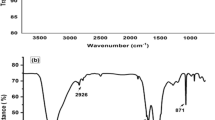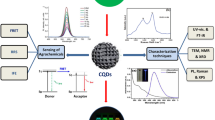Abstract
This paper reports the fabrication and utility of a new solid sensor, which allows the quantitation of silver ions acting as catalyst at the low micromolar level. The optical sensor was prepared by incorporating both reagents, pyrogallol red (PGR) and 1,10-phenanthroline (Phen), in a nylon membrane. The effect of parameters in determining silver-catalyzed oxidation of PGR by persulfate in the presence of Phen as an activator was studied and optimized for achieving suitable sensitivity. Semiquantitative analysis can be performed by visual inspection of the color of the sensor by comparing it with standard responses and quantitative analysis can be carried out by its diffuse reflectance (DR) measurement or by a digital image-processing tool (GIMP) using a smartphone. The sensor exhibited a linear relationship toward Ag(I) concentrations ranging from 0.4 to 10 μM or 1–25 μM and limits of detection of 0.1 μM or 0.3 μM for incubation times of 50 and 30 min, respectively. The relative standard deviation achieved for several batches of sensors was around 2%. The analysis of water samples from tap and refrigerating circuits containing solid biocides, which leach silver ions, prove that this portable and sustainable sensor is successfully operational in real situations.

Graphical abstract







Similar content being viewed by others
References
Campíns-Falcó P, Jornet-Martínez N, Moliner-Martínez Y, Molins-Legua C. Trends for the development of in situ analysis devices. In: Meyers RA, Valcarcel M, editors. Encyclopedia of analytical chemistry. Environment: water and waste). Chichester: Wiley; 2017. https://doi.org/10.1002/9780470027318.a9593.
Jornet-Martínez N, Bocanegra-Rodríguez S, González-Fuenzalida RA, Molins-Legua C, Campíns-Falcó P. In situ analysis devices for estimating the environmental footprint in beverages industry. Grumezescu AM, Holban AM, editors. Processing and sustainability of beverages. Elsevier: Amsterdam. 2019; Volume 2, Chapter 9. p. 275–317.
Jornet-Martínez N, Moliner-Martínez Y, Herráez-Hernández R, Molins-Legua C, Verdú-Andrés J, Campíns-Falcó P. Designing solid optical sensors for in situ passive discrimination of volatile amines based on a new one-step hydrophilic PDMS preparation. Sens Actuators B Chem. 2016;223:333–42.
Bocanegra-Rodríguez S, Jornet-Martínez N, Molins-Legua C, Campíns-Falcó P. Delivering inorganic and organic reagents and enzymes from zein and developing optical sensors. Anal Chem. 2018;90:8501–8.
Woo KJ, Hye CK, Ki WK, Shin S, So HK, Yong HP. Antibacterial activity and mechanism of action of the silver ion in Staphylococcus aureus and Escherichia coli. Appl Environ Microbiol. 2008;74:2171–8.
Kędziora A, Speruda M, Krzyżewska E, Rybka J, Łukowiak A, Bugla-Płoskońska G. Similarities and differences between silver ions and silver in nanoforms as antibacterial agents. Int J Mol Sci. 2018;19:444.
DiRienzo M. New applications for silver. The LBMA Precious Met Conf. 2006:85–90. https://www.rxsilver.com/DiRienzo-Silver.pdf
World Health Organization (WHO). Guidelines for drinking-water quality. 2nd ed. Vol. 2. Geneva: WHO; 1996.
Environmental Protection Agency (EPA). Integrated risk information system. Silver; CASRN 7440-22-4, (1987) 1–13.
Firooz AR, Ensafi AA, Kazemifard N, Sharghi H. A highly sensitive and selective bulk optode based on benzimidazol derivative as an ionophore and ETH5294 for the determination of ultra trace amount of silver ions. Talanta. 2012;101:171–6.
Roger T, Bhakoo M, Zhang Z. Bacterial adhesion and biofilms on surfaces. Prog Nat Sci. 2008;18:1049–56.
Neu TR, Laurence JR. Extracellular polymeric substances in microbial biofilms. Biological relevance of microbial glycosylated components. E Sci. 2019;37:735–58.
Kerr CJ, Osborn KS, Rickard AH, Robson GD, Handley PS. Biofilms in water distribution systems. Handbook of water and wastewater microbiology. London: Academic; 2003. p. 757–75.
Czaczyk K, Myszka K. Biosynthesis of extracellular polymeric substances (EPS) and its role in microbial biofilm formation. Polish J Environ Stud. 2007;16:799–806.
Zia S, Afzali D, Ali M, Mohammad Y. Ligandless dispersive liquid-liquid microextraction for the separation of trace amounts of silver ions in water samples and flame atomic absorption spectrometry determination. Talanta. 2009;80:875–9.
Karimi MA, Mohammadi SZ, Mohadesi A, Hatefi-mehrjardi A. Determination of silver (I) by flame atomic absorption spectrometry after separation/preconcentration using modified magnetite nanoparticles. Sci Iran. 2011;18:790–6.
U.S. EPA. Determination of metals and trace elements in water and wastes by inductively coupled plasma-atomic emission spectrometry. Revision 4.4. Cincinnati, OHIO 45268; 1994.
Dadkhah A, Rofouei MK, Mashhadizadeh MH. Synthesis and characterization of N,N-bis(benzophenone imine)formamidine as ionophores for silver-selective electrodes. Sens Actuators B Chem. 2014;202:410–6.
Hassouna MEM, Elsuccary SAA, Graham JP. N,N-Bis(3-methyl-1-phenyl-4-benzylidine-5-pyrazolone)propylenediamine Schiff base as a neutral carrier for silver (I) ion-selective electrodes. Sens Actuators B Chem. 2010;146:79–90.
Zejli H, De Cisneros JLH, Naranjo-rodriguez I, Temsamani KR. Stripping voltammetry of silver ions at polythiophene-modified platinum electrodes. Talanta. 2007;71:1594–8.
Safavi A, Ahmadi R, Mohammadpour Z. Colorimetric sensing of silver ion based on anti aggregation of gold nanoparticles. Sens Actuators B Chem. 2017;242:609–15.
Haghnazari N, Alizadeh A, Karami C, Hamidi Z. Simple optical determination of silver ion in aqueous solutions using benzo crown-ether modified gold nanoparticles. Microchim Acta. 2013;180:287–94.
González-Fuenzalida RA, Moliner-Martínez Y, González-Béjar M, Molins-Legua C, Verdú-Andres J, Pérez-Prieto J, et al. In situ colorimetric quantification of silver cations in the presence of silver nanoparticles. Anal Chem. 2013;85:10013–6.
Sánchez-Pomales G, Mudalige TK, Lim J, Linder SW. Rapid determination of silver in nanobased liquid dietary supplements using a portable X-ray fluorescence analyzer. J Agric Food Chem. 2013;61:7250–7.
Shahamirifarda SA, Ghaedia M, Hajati S. A new silver (I) ions optical sensor based on nanoporous thin films of sol–gel by rose bengal dye. Sens Actuators B Chem. 2018;259:20–9.
Chen YJ, Liu CY, Tsai DY, Yeh YC. A portable fluorescence resonance energy transfer biosensor for rapid detection of silver ions. Sens Actuators B Chem. 2018;259:784–8.
Omran OA, Elgendy FA, Nafady A. Fabrication and applications of potentiometric sensors based on p-tert-butylthiacalix[4]arene comprising two triazole rings Ionophore for silver ion detection. Int J Electrochem Sci. 2016;11:4729–42.
Sangmyung L, Kuewhan J, Chanho P, Junesseok Y, Taegyu K, Chulhwan I, et al. Ultra-sensitive in situ detection of silver ions using a quartz crystal microbalance. New J Chem. 2015;39:8028–34.
Sevillano-Cabeza A, Medina-Escriche J, Llobat-Estelles M, Martin-Penella M. Study of the silver-catalysed pyrogallol red-peroxodisulphate reaction with 1,10-phenanthroline as activator by a kinetic spectrophotometric method. Analyst. 1986;111:1417–22.
Abbasi S, Barzegaramiri H, Farmany A. Determination of trace amounts of silver (I) in the presence of activator with a kinetic method. Rare Metals. 2014;33:731–6.
World Health Organization (WHO) Guidelines for drinking-water quality, 4th ed. Geneva: WHO; 2011.
Health and Safety Executive. Legionnaires’ disease 2014. https://www.hse.gov.uk/pUbns/priced/hsg274part2.pdf. Accessed Jan 2020.
Jornet-Martínez N, Hakobyan L, Argente-García A, Molins-Legua C, Campíns-Falcó P. Nylon-supported plasmonic assay based on the aggregation of silver nanoparticles: in situ determination of hydrogen sulfide-like compounds in breath samples as a proof of concept. ACS Sens. 2019;48:2164–72.
Miller JN, Miller JC. Statistics and chemometrics for analytical chemistry. 4th ed. Essex: Pearson; 2000, p. 271.
Beynon RJ, Bond JS. Proteolytic enzymes: a practical approach. Oxford: IRL/OUP; 1989. p. 245.
López-Alarcón C, Lissi E. A novel and simple ORAC methodology based on the interaction of pyrogallol red with peroxyl radicals. Free Radic Res. 2006;40:979–85.
Argente-García A, Muñoz-Ortuño M, Molins-Legua C, Moliner-Martínez Y, Campíns-Falcó P. A solid device based on doped hybrid composites for controlling the dosage of the biocide N-(3-aminopropyl)-N-dodecyl-1,3-propanediamine in industrial formulations. Talanta. 2016;147:147–52.
Acknowledgements
The authors would like to thank the European Union - European Regional Development Fund and Ministerio de Ciencia, Innovación y Universidades- Agencia Estatal de Investigación of Spain (Project CTQ-2017-90082-P) and the Generalitat Valenciana (PROMETEO Program 2016/109) for financial support. S.B.-R. expresses her gratitude to PROMETEO program for her pre-doctoral grant. N.J.-M. expresses thanks to the Universitat of Valencia for her post-doc funding. The authors would like to thank Mipel SA company for samples.
Author information
Authors and Affiliations
Corresponding authors
Ethics declarations
Conflict of interest
The authors declare that they have no conflict of interest.
Additional information
Publisher’s note
Springer Nature remains neutral with regard to jurisdictional claims in published maps and institutional affiliations.
Electronic supplementary material
ESM 1
(PDF 114 kb)
Rights and permissions
About this article
Cite this article
Bocanegra-Rodríguez, S., Jornet-Martínez, N., Molins-Legua, C. et al. Portable solid sensor supported in nylon for silver ion determination: testing its liberation as biocide. Anal Bioanal Chem 412, 4393–4402 (2020). https://doi.org/10.1007/s00216-020-02680-y
Received:
Revised:
Accepted:
Published:
Issue Date:
DOI: https://doi.org/10.1007/s00216-020-02680-y




